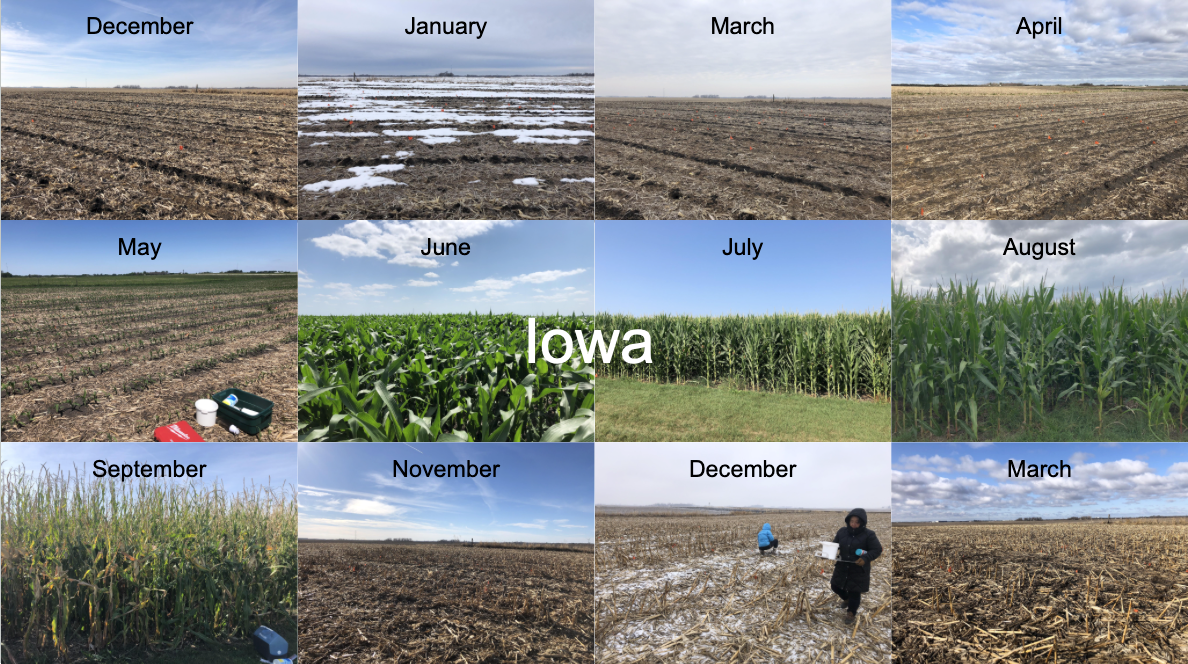Variability of the Soil Microbiome Across Seasons
When should I collect samples for soil biological analysis?
In many ecosystems, the community of plants and animals you see changes with the seasons. Grasses grow tall in the summer, hibernating animals disappear during the winter, and some birds migrate in the fall. Similarly, seasonal changes may be seen in the soil microbiome—the community of microscopic organisms (or microbes) that live in the soil. Since these organisms aren’t visible to human eyes, scientists can use metagenomics—the process of sequencing all DNA in a sample—to learn what microbes are in a soil and how they change over time. Since metagenomics is a new technology, scientists are still learning a lot about how the soil microbiome changes throughout the year. However, many different studies have shown that there are changes in microbial communities as seasons pass (1, 2, 3) which may be because of seasonal changes in moisture and nutrient availability (4).
At Trace Genomics, we use metagenomics alongside our proprietary database and analytical pipeline to provide growers with the highest-quality information possible about their soil biology. With TraceCOMPLETE™, we provide actionable data based on: 1) what microbes are living in the soil (including pathogen load), and 2) what functional role the microbes have (which can inform soil fertility management).
Since December 2020, our expert team of soil microbiologists have been analyzing agricultural soils from the same fields in Iowa, California, and Texas once per month to understand the best time of year to recommend collecting soil samples for biological analysis. Their findings agree with peer-reviewed literature: the soil microbiome changes across seasons. For this reason, it is important for growers to collect samples around the same time each year to get the most value from their data. Collecting multiple samples within a year may be valuable, however they can only be benchmarked against other samples taken during the same season.
Benefits to sampling in the fall
Pathogen loads are highest in the fall, after the crop is harvested. Since the pathogens live in the soil through the winter, this information lets growers know where there will be the most pathogen pressure in the spring. They can use this information to select pathogen-resistant seeds or an effective seed treatment for those areas. Additionally, TraceCOMPLETE data can inform fertility management strategies for the next year, and sampling in the fall allows them time to adequately prepare.
Benefits to sampling in the spring
While fall sampling allows for more preparation time, collecting samples in the spring provides a better picture of pathogen levels in fields immediately before planting. This may reveal that a pathogen that was low abundance in the fall has increased in abundance to be a more urgent concern. Action can be taken to apply seed treatments before planting or adjust in-season management to prepare. Additionally, having temporal data can be valuable for fields with crop rotations. For example, in a field where spring corn is being planted and is rotating to soy next spring, any soy pathogens in the field can be preemptively managed.
To conclude:
The soil microbiome changes throughout the year, so sampling at the same time each year is crucial for cross-year comparisons. Sampling in the fall gives growers time to prepare pathogen control and fertility strategies for the next year, while sampling in the spring shows the pathogen threat immediately before planting.
About the author: Dr. Tuesday Simmons is the Science Writer at Trace Genomics. She earned her Ph.D. in Microbiology from the University of California, Berkeley, studying the root microbiome of cereal crops.
References:
- Lauber, C., Ramirez, K., Aanderud, Z. et al. Temporal variability in soil microbial communities across land-use types. ISME J. 7, 1641–1650 (2013). https://doi.org/10.1038/ismej.2013.50
- Becker, M., Hellmann, M. & Knief, C. Spatio-temporal variation in the root-associated microbiota of orchard-grown apple trees. Environmental Microbiome. 17, 31 (2022). https://doi.org/10.1186/s40793-022-00427-z
- Fox, A., F. Widmer, and A. Lüscher. Soil microbial community structures are shaped by agricultural systems revealing little temporal variation. Environmental Research. 214, 3 (2022). https://doi.org/10.1016/j.envres.2022.113915
- Lacerda-Júnior GV, MF Noronha, L Cabral, TP Delforno, STP de Sousa, PI Fernandes-Júnior, IS Melo and VM Oliveira. Land Use and Seasonal Effects on the Soil Microbiome of a Brazilian Dry Forest. Front. Microbiol. 10, 648 (2019) http://doi.org/10.3389/fmicb.2019.00648




